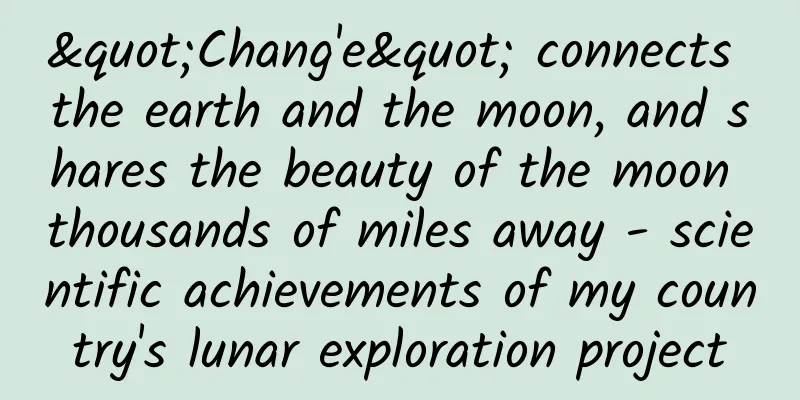"Chang'e" connects the earth and the moon, and shares the beauty of the moon thousands of miles away - scientific achievements of my country's lunar exploration project

|
"When will the bright moon appear? I raise my cup to ask the sky. I wonder what year it is in the palace in the sky." Since ancient times, the Chinese people have had a unique and profound affection for the moon, leaving behind countless famous works. When people look up at the moon, they will be intoxicated by its tranquil beauty, which will arouse their longing for their hometown and relatives, and will arouse the sadness of loneliness and frustration in their hearts, and will trigger their understanding of the universe and life. The moon has engraved a precious heritage in Chinese culture. With the development of the Chang'e project, people began to have infinite expectations and heated discussions. When can we land on the moon, explore the Guanghan Palace, and look at the laurel tree? The "Chang'e Project" is the "alias" of China's lunar exploration project. It is the third milestone of China's space activities after artificial satellites and manned space flight, and it is also the starting point for China's space industry to expand from near-Earth to deep space. It is implemented in accordance with the three-step strategy of "orbiting, landing, and returning": Chang'e-1 and Chang'e-2 satellites orbit the moon and conduct global, holistic and comprehensive exploration of the moon; Chang'e-3 and Chang'e-4 probes soft-land in the Moon's Rainbow Bay area and the South Pole-Aitken Basin on the far side of the moon, respectively, to test soft landing and lunar rover technology, and conduct field exploration and lunar-based astronomical observations in the landing area; Chang'e-5 realizes exploration and sampling on the lunar surface and sends the samples back to Earth. The Chang'e Project has won five battles and five victories, and has achieved rich scientific results. It is a key step taken by my country on the road to building a strong country in science and technology and aerospace. Chang'e-1's scientific achievements Chang'e-1 achieved the first lunar exploration and made four major scientific achievements. First, it obtained a three-dimensional image of the entire lunar surface, which is also the first time in the world. Before this, other countries exploring the moon mainly drew a plane map of the moon, and there were relatively few three-dimensional maps, and it was difficult to shoot in high-latitude areas. Chang'e-1 is equipped with a CCD stereo camera and a laser altimeter to draw a three-dimensional map of the moon. Scientists can finely divide the basic structure and geomorphic units of the lunar surface, providing a basis for in-depth understanding of the moon and landing site selection. The second is to explore the distribution of important elements and mineral resources on the moon. Chang'e-1 explored the geographical distribution of 14 important elements, including iron, titanium, uranium, potassium, silicon, aluminum, and rare earths, laying the foundation for the development of lunar mineral resources and the construction of a lunar base. The third is to detect the thickness of the lunar soil. The moon has no atmosphere. Under the influence of solar wind, the lunar soil contains a large amount of helium-3, which is a rare, safe and clean nuclear fusion fuel on Earth. Chang'e-1 used microwave radiation technology to conduct the world's first lunar soil thickness detection, and estimated that its reserves are more than 1 million tons, which can meet the energy needs of the Earth for 10,000 years. Fourth, the detection of the Earth-Moon space environment. The Moon is 380,000 kilometers away from the Earth and is located in the far magnetic tail region of the Earth's magnetic field. Chang'e-1 detected high-energy particles of solar cosmic rays and solar wind plasma, which is of great significance for a deeper understanding of the space physics phenomena and their impacts on the Earth and near the Moon. Chang'e-2's scientific achievements Chang'e-2 builds on the work of its predecessors and continues the comprehensive exploration of the moon with more advanced technology and higher precision. It also lays a solid foundation for subsequent lunar exploration and landing missions and has achieved scientific results in many areas. First, higher-resolution three-dimensional images of the lunar surface were obtained. Chang'e-1 had a resolution of 120 meters, and Chang'e-2 had a resolution of 7 meters, and the image quality and data consistency reached the world's highest level. The second is to prepare data and technology for the Chang'e-3 soft landing mission. Soft landing requires high-precision images of the landing site. For this purpose, Chang'e-2 enters an elliptical orbit and uses the 61 seconds of each lunar cycle to pass over the Rainbow Bay area to take close-up images of the lunar surface at an altitude of 15 kilometers. In addition, the landing work strategy of the Chang'e-3 main engine was partially verified. In terms of comprehensive lunar exploration and exploration of the Earth-Moon and near-Moon space environments, Chang'e-2 was the first in the world to use lanthanum bromide crystals to detect the distribution of elements on the lunar surface, the first to cover the entire moon with X-rays, and to observe solar X-ray bursts and cosmic gamma bursts. After completing all the tasks, Chang'e-2 started a more magnificent journey. It departed from the lunar orbit and flew to the Sun-Earth Lagrange L2 point 1.5 million kilometers away for a 10-month scientific exploration mission. After that, it continued to go deep into the starry sky and made a close rendezvous with the asteroid 4179 Toutatis 7 million kilometers away from the Earth. It took high-resolution optical images and became my country's first interplanetary probe. Chang'e-3's scientific achievements The Chang'e-3 mission made my country the third country in the world to achieve a soft landing on the moon. The probe and lunar rover "measured the moon, observed the earth, and surveyed the sky", achieving fruitful scientific results. Lunar surveying refers to the on-site detection of the lunar surface topography, geological structure and resource distribution. In the landing area, Chang'e-3 used lunar radar to detect the shallow structure of the moon and the thickness of the lunar soil, drew the first lunar geological profile, and discovered a new type of basalt. Based on the chemical and mineral composition of the lunar soil in the landing area, the thickness of the lunar soil and the depth of basalt, scientists determined that this area still had volcanic eruptions 2.5 billion years ago, and put forward new insights into the late magmatic activity and geological evolution of the moon. Earth observation refers to Chang'e-3's detection of the Earth's plasma layer. The Earth's plasma layer is a donut-shaped area in the Earth's magnetosphere, filled with low-temperature and dense ions bound by the Earth's magnetic field lines. Through long-term fixed-point observations, Chang'e-3 obtained three-dimensional images and discovered the double-oval structure of the plasma layer, showing how the Earth's space environment is affected by solar activity and geomagnetic field activity. The moon rotates slowly, has no atmosphere, and has a thin ionosphere, making it an ideal place for astronomical observation. Chang'e-3 served as an astronomical telescope on the moon, conducting near-ultraviolet sky surveys in multiple sky regions, monitoring the long-term light variation of eight eclipsing binary stars and RR Lyrae variable stars, providing a basis for testing binary star theoretical models; and conducting high-precision detection of the water content in the lunar exosphere, correcting the previous erroneous conclusion that the Hubble telescope detected a large number of water molecules on the moon. Chang'e-4's scientific achievements Chang'e-4 is a new record in human lunar exploration created by China's space program. It achieved the first soft landing and patrol survey of a human probe on the far side of the moon, the first communication between the far side of the moon and a ground station via a relay satellite, and the first low-frequency radio astronomical observation on the far side of the moon. New records bring new results. Chang'e-4 has updated people's understanding of the lunar far side topography, material composition, early impact history, magma eruption history, lunar soil formation mechanism and space weathering characteristics. Through field exploration, Chang'e-4 learned for the first time the composition of deep lunar materials, revealed the complex impact history of the Aitken Basin in the South Pole, and obtained the geological stratification structure of about 400 meters below the patrol path, bringing new insights into the study of the geological evolution of the far side of the moon. Chang'e-4 detected neutrons, radiation doses and neutral atoms on the lunar surface. The detection results provided important support for the study of the microscopic interaction between the solar wind and the lunar surface; promoted the understanding of the radiation risks on the lunar surface, and found that the radiation dose to astronauts in the lunar surface environment is 200 times that of the Earth, providing a basis for future radiation hazard research and protection design for astronauts landing on the moon. In addition, taking advantage of the clean electromagnetic environment on the back of the moon, Chang'e-4 carried out low-frequency radio astronomical observations and obtained a large amount of data, filling the gap in this field for mankind. This is of great significance in studying the low-frequency radio characteristics of the sun and the low-frequency radio environment of the lunar surface. Chang'e-5's scientific achievements Chang'e-5 realized the return of lunar samples by humans after 44 years. It is my country's most complex and difficult space mission to date, and is also the crystallization of my country's highest space technology level. In addition to breakthroughs in a series of core key technologies such as lunar surface sampling, lunar surface takeoff, lunar orbit rendezvous and docking, and high-speed reentry and return, scientists have continuously produced new results in the process of studying lunar samples, and achieved new progress in important scientific issues such as lunar evolution and solar weathering on the lunar surface. The study found that the basalt in the Chang'e-5 landing area was formed 2.030±0.04 billion years ago, which is younger than the samples collected by the United States and the Soviet Union, proving that the moon still had volcanic activity 2 billion years ago. This pushed back the time when the moon's magmatic activity stopped by 800 million years. At the same time, the investigation of the rock chemistry and magma water content in this area also revealed the process of late magmatic activity on the moon. Due to the lack of atmospheric protection, the lunar surface is subjected to severe space weathering such as micrometeorite impacts, solar wind and space radiation, which has shaped the microscopic morphology and crystal structure of lunar surface materials. The analysis of lunar surface weathering is of great value to the study of planetary habitable environments. Prior to this, the United States and the Soviet Union collected samples in low-latitude areas of the moon, which was not clear enough to reveal the mechanisms of several types of space weathering. Chang'e 5 collected samples in high-latitude areas, providing a unique perspective for space weathering research. As the research continues to deepen, Chang'e-5 will bring more important insights, let us look forward to it. |
<<: Protecting Northeast China's black soil and safeguarding China's "rice bowl"
>>: College entrance examination scores in many provinces announced! Quick check!
Recommend
The driving force behind polar cold waves: How does the jet stream shape the Earth’s climate and weather?
Tuchong Creative The westerly jet stream is a pow...
Tencent QQ: Please cherish your account rights. More than 13,000 QQ accounts have been blocked this year.
On October 31, Tencent QQ Security Center release...
Baofeng TV received an investment of 800 million yuan. Can the former "Little LeTV" break through the Internet TV market?
2017 was not a easy year for the Internet TV indu...
The teeth we use to eat may have been fish scales a long time ago!
Produced by: Science Popularization China Author:...
Operational skills of Alipay products!
It turns out that Alipay is not only a payment pr...
The "rain" on these planets is not water, but gems? Or iron?
Plants and animals on Earth cannot live without r...
A "new chapter" for China's railways! my country's first unmanned heavy-haul train test was successful
Author: Shi Xiangqi and Li Chuanfu On September 2...
Price inquiry for customized Xianning animation mini program. How much does it cost to customize Xianning animation mini program?
More and more businesses are paying attention to ...
HTC's failure to adapt to local conditions and its fatal shortcomings
HTC was once the king of the Android camp. In Apr...
Too Dirty! The Shower Head at Home is a “Bacteria-Heavy Area”...
Editor: He Jian How often do you clean your showe...
The number of followers increased by 4.1 million in two weeks! How to make Douyin’s automobile account a hit?
1. What content formats are available for automot...
How to achieve user growth? Share 4 new customer acquisition techniques!
In an era where traffic costs are rising, efficie...
A high density of "water pandas" was found in a reservoir in Chun'an! They are older than dinosaurs
Recently, a high density of moon jellyfish was di...
How to make https certificate and HTTPS?
1. Why must we upgrade to HTTPS? The HTTP protoco...









